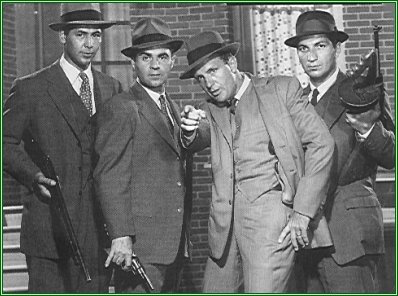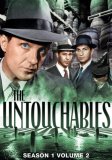| Reviews & Columns |
|
Reviews DVD TV on DVD Blu-ray 4K UHD International DVDs In Theaters Reviews by Studio Video Games Features Collector Series DVDs Easter Egg Database Interviews DVD Talk Radio Feature Articles Columns Anime Talk DVD Savant Horror DVDs The M.O.D. Squad Art House HD Talk Silent DVD
|
DVD Talk Forum |
|
|
| Resources |
|
DVD Price Search Customer Service #'s RCE Info Links |
|
Columns
|
|
|
Untouchables - Season 1, Volume 2, The
After putting Al Capone (Neville Brand) behind bars in the two hour Desilu/Westinghouse Playhouse episodes that ultimately served as a pilot for what became The Untouchables TV series, first season shows find Special Agent Eliot Ness (Stack) on the trail of other (lesser) mobsters in Prohibition-era Chicago and throughout America. Possibly owing to the fact that the series was adapted from Ness's posthumously-published best-seller and Desilu therefore wanted to remain on good terms with his estate, the character (rather than Stack's performance) is single-minded and methodical but little else. He is ultimately, as Bacharach points out in his review, cardboard, enigmatic but frustratingly so with no shading: a flawless hero. (The same can be said of Ness's rotating roster of assistant agents: Nick Georgiade, Anthony George, etc.) In most shows, Stack's character's function is largely expository, to deliver dialogue that keeps the story moving forward.
He's certainly much less colorful than the show's parade of underworld figures, a "Rogue's Gallery," to coin a phrase popularized on TV's Batman. They, of course, are irredeemably ruthless with no more shading than Ness, and the effect of all this is that drama almost invariably falls on those hapless souls caught in the middle: gangsters' molls, innocent accountants working for and gamblers heavily in debt to The Mob, businessmen being squeezed into bankruptcy with demands of "protection" money.
The result is a general sameness to the stories, and because the drama relies so heavily on these one-shot victims caught in the middle (making it nearly an anthology show) the problem with the series is two-fold: (1) the quality of the show rises and falls based on the level of the writing, which more often than not isn't all that great, and (2) weaker episodes can't fall back on its leading character for support because he's just not very compelling.
In its day, however, The Untouchables was a Big Deal for a variety of reasons. After husband-wife powerhouse Desi Arnaz and Lucille Ball bought RKO's two big studios (in Hollywood and Culver City) Desi launched an ambitious expansion of Desilu well beyond I Love Lucy. As Ed Robertson notes in his excellent, highly recommended article on The Untouchables, Arnaz rather ingeniously shot the Desilu/Westinghouse Playhouse film on a budget of $600,000 even though he'd only be getting $250,000 from CBS. He figured, rightly as it turned out, that with a little more polish he could release the film theatrically overseas (as The Scarface Mob) and get his money back while providing the network a show with production values second-to-none.
Arnaz assigned protegee producer Quinn Martin (The Streets of San Francisco) to the series, which retained much of the original film's lavishness. Obviously, they were able to endlessly recycle period costumes, automobiles and props, but even ordinary episodes are impressive from a production standpoint. In "Head of Fire, Feet of Clay," a boxing story, much of the action is set in and around a boxing area. During matches, where most TV producers would simply fill a front row with extras and keep everything beyond it in darkness, here they actually filled a soundstage with what looks to be at least several hundred costumed extras. Similarly, street scenes (probably filmed on the Culver backlot) are by TV standards unusually well-populated with both extras and period cars.
Though in the end the show's setting proved limiting, it nevertheless offered a genre counterpoint to the flood of TV Westerns that dominated the Prime Time schedule when the show was new. Though its stories mirrored those of TV Westerns in many ways, gangster movies of the early-1930s had become popular on TV only recently, while it compared not unfavorably with similar, concurrent films like the Jimmy Stewart The F.B.I. Story (1959).
To some degree, Arnaz (and Martin) were thumbing their noses at the film industry's Production Code, which had placed tight restrictions on the level of violence that was permitted in the wake of the most violent gangster movies of the early-1930s. The show was condemned by many (and the subject of three Congressional investigations) for its cold-blooded murders and hail of tommygun fire, and the low-rated ABC network (which aired the series), blessed with a rare hit show, probably to some degree turned a blind eye to the series' weekly bloodbaths. As Robertson points out, the show's slick editing and mix of noirish camerawork (with much night-for-night photography) and editing with newsreel-like verisimilitude (epitomized by Walter Winchell's own rat-a-tat-tat narration) only served to make episodes both more movie-like and realistic.
Video & Audio
The Untouchables - Season One, Volume 2 presents the final 14 episodes from the first season on four single-sided dual-layered discs. The full-frame shows look exceptionally good: very sharp, excellent contrast. Because they were presumably struck from the original camera negative, there's an inconsistency to the film stock: some shots are strictly shades of gray while others have an almost sepiatone quality. The DVD case notes that "some episodes may be edited from their original broadcast versions," but except for an abrupt fade-out where the show's sponsors would be identified, the episodes this reviewer sampled were otherwise uncut and not time-compressed. The English Dolby Digital mono sounded just fine to me; an alternate Spanish mono track is included, along with optional English, Spanish, and Brazilian Portuguese subtitles. .
Extra Features
The only extra is a pretty good one: a 1966 episode of The Lucy Show called "Lucy and the Gun Moll," featuring an extended parody of The Untouchables with guest stars Robert Stack, Georgiade, and Bruce Gordon, whose Frank Nitti character was a popular semi-regular.
Parting Thoughts
It doesn't really hold up, but The Untouchables is interesting in other ways, especially for its great line-up of guest stars that include Marc Lawrence, Jim Backus, Harry Guardino, Dan O'Herlihy, John Hoyt, Claude Akins, Dick York, Nita Talbot, Leslie Nielsen, Anne Francis, Charles McGraw, Thomas Mitchell, Peter Falk*, Nehemiah Persoff, Jack Warden, Madlyn Rhue, Richard Anderson, Dick Foran, Allison Hayes, Elizabeth Montgomery, and Harold J. Stone. It's extremely well-produced; one only wishes its teleplays were better overall. Recommended.
* A bit of trivia: Mitchell and Falk appear on the same show; both would later play Lt. Colombo.
Film historian Stuart Galbraith IV's most recent essays appear in Criterion's new three-disc Seven Samurai DVD and BCI Eclipse's The Quiet Duel.
|
| Popular Reviews |
| Sponsored Links |
|
|
| Sponsored Links |
|
|
| Release List | Reviews | Shop | Newsletter | Forum | DVD Giveaways | Blu-Ray | Advertise |
|
Copyright 2024 DVDTalk.com All Rights Reserved. Legal Info, Privacy Policy, Terms of Use,
Manage Preferences,
Your Privacy Choices | |||||||














